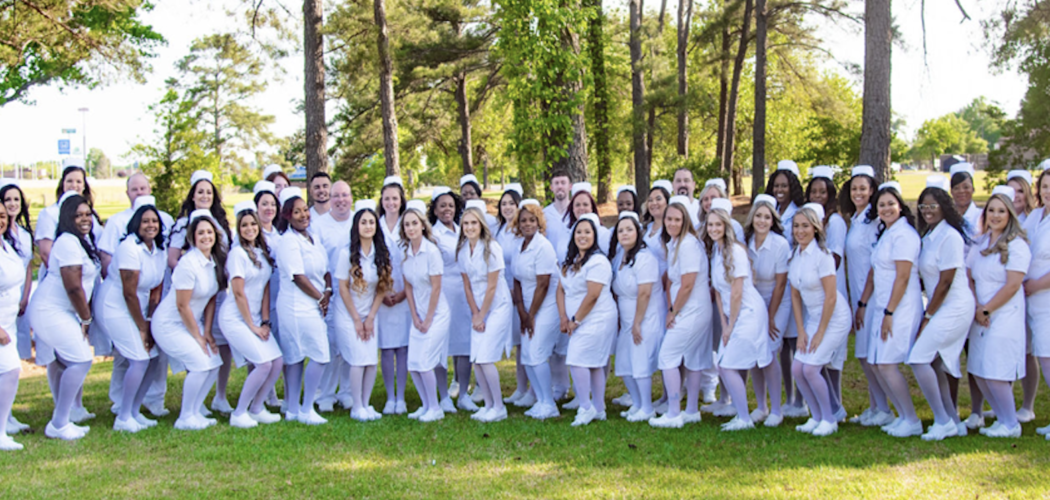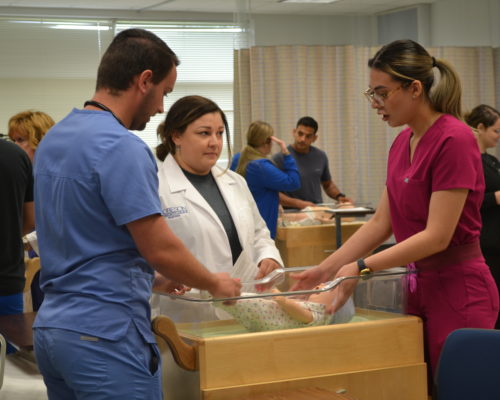
How RCC is taking steps to address the nursing shortage
As the nursing shortage continues to worsen, Robeson Community College has been busy behind the scenes trying to create ways to lessen the impact seen in our area.
According to the United States Registered Nurse Workforce Report Card and Shortage Forecast, it is expected that the RN shortage will be the most intense in the Southern and Western states, North Carolina included. The shortage has been spreading across the country since 2009 and is projected to continue to grow until 2030.
“Yes, there is a shortage,” stated Dr. Eva Meekins, the director of nursing programs at RCC. “We are in a rural healthcare shortage desert. We haven’t really felt the impact of it yet, but it is coming.”
It is estimated that the U.S. needs more than 200,000 new registered nurses every year until 2030 to meet the demand, but with the recent pandemic, many nurses are exhausted. Nationwide, one in five registered nursing jobs are unfilled.
“We have to ask, what do we have to offer students,” Meekins said. “We have to be very strategic and innovative in attracting students to the Robeson Community College and to the profession.”
Meekins says that one of the solutions to turning the shortage around is finding more nurses who are willing to teach. She says a nursing faculty shortage is part of the problem.
“By mandate, there has to be a certain faculty-student ratio in every class,” Meekins says. “It makes sense because you want nursing students to have that one-on-one interaction with the instructor, but in the end, creates our own shortage.”
Why aren’t there more nursing faculty available?
To be qualified to teach nursing, an individual must have at least a Bachelor of Science in nursing, and in most cases, a Master of Science in nursing is preferred. Meekins says there is also a nursing faculty pay disparity, and most nursing instructors do it to give back to the profession.
“Those of us who are educators in nursing are doing it on purpose, it is a sacrifice in many ways,” said Meekins. “Nurses are well aware that they can make a much more lucrative salary working in the profession.”
“We have to find those who are qualified and willing to teach so that we can continue to attract and admit more nursing students,” Meekins explained.
Which is one reason she has been innovative in creating mentorships in the program.
“Our second-year students help to mentor our first-year students,” Meekins said. “By doing this, we are creating a potential faculty pipeline. Our two most recent instructors hired are graduates of the program.”
Meekins says that she also had the wisdom to pursue accreditation of the program from the National League of Nursing. Accreditation is not required by the North Carolina Board of Nursing nor the North Carolina Community College system.
“We wanted to take this extra step for our program to let our students, our community, and this region know that Robeson Community College is exceptional, and our graduates are exceptional as well,” Meekins said. “Accreditation demonstrates excellence and a commitment to continuous process improvement and becoming accredited was hard work, but we believe that it will pay off dividends in the future.”
Out of the 58 community colleges in North Carolina, Robeson Community College became the 6th college to become fully accredited by the National League of Nursing Commission on Nursing Education Accreditation, and the only college in Southeastern North Carolina to earn this distinction of honor.
Meekins says that graduates of the ADN nursing program will now become potentially eligible for federal jobs. and that NLN CNEA accreditation will open new doors of opportunities for students, setting the college apart from its competition and making the program more attractive to prospective students.
Another aspect that sets RCC apart is its diversity.
“We are very diverse,” says Meekins. “We have students of all races and cultures, and we have several students from other countries enrolled.”
The program attracts first-generation college students, military-affiliated and veteran students, Americans from Asia, and the Middle East, as well as students of Hispanic and African descent.
Retention is also a big factor in curbing the shortage.
“One of our students drives from Apex every day. It is 60 miles one way, but they are determined,” Meekins said. “Usually if we can get the student, we can keep them, more so than a university.”
But Meekins also admits that sometimes life happens, and that’s especially true in the community college setting.
“We had an amazing LPN student, but life kicked in and she had to go to work to support her family,” Meekins said.
That’s why Meekins said that she wishes there were more targeted resources for nursing students so that students like this one could have stayed on track to finish their degree.
“It’s not just about getting money and being funded,” Meekins said. “I would love to see more scholarships and grants for our students so that they didn’t have to work while in school… every student that we have counts, and when we lose one because of financial hardships, it doesn’t just hurt the student, it hurts everyone in our community, because by 2030, we are in trouble, and that is only 7 years away.”
Meekins says that she and her staff often looks for ways to engage students and keep them motivated while in school. One example she provided was the forming of a human pink ribbon on the center lawn to raise awareness of breast cancer.
“It continues to get bigger every year,” Meekins said. “It engages them and keeps them connected with each other, we let it be student-centered and student-focused – they make it happen.”
“Our retention rates have gone up significantly for students,” Meekins stated. “We currently have 38 second-year associate degree nursing students, 53 first-year students, and 32 practical nursing students.”
The associate degree nursing program recently saw the largest graduating class in the history of the program with 48 students completing their degrees. Adding to the increase, was a rise in a paramedic to RN graduates, another pathway designed to get more registered nurses in the pipeline.
What’s the secret ingredient?
The faculty in the department have created opportunities for students to have access to more resources, including a great partnership that has been formed with counselors who work with students on stress and anxiety through workshops.
“Students tend to not leave if they are connected to someone,” Meekins said. “We also are not intimidated by listening to our students, we let them speak and give us feedback. Our end goal is for them to become Registered Nurses.”












